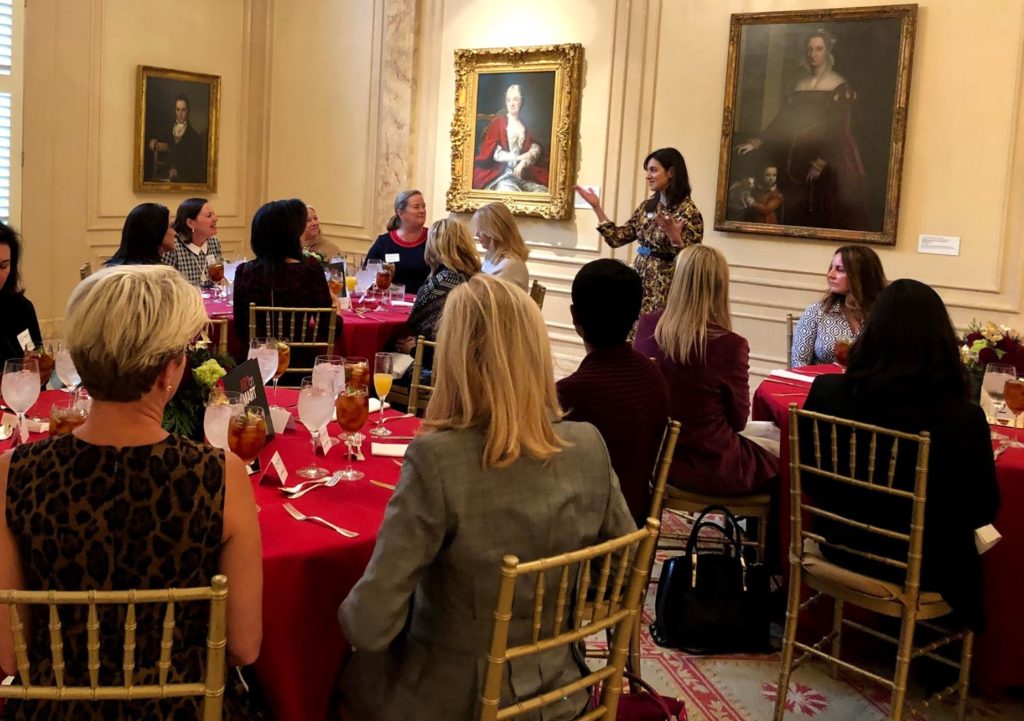Throughout history, the arts have been indicative of beauty, human connectedness, prosperity, creativity, and freedom of expression. By stimulating the senses, emotions, and thoughts, arts can incorporate beauty into an environment, give communities a stronger sense of identity, and challenge the status quo. Given all these options, the creativity and collaboration of the arts can also be woven into the free market economy to create work and wealth.

Last week, a Policy Circle led by co-founder Sylvie Légère gathered at The National Museum of Women in the Arts in Washington, D.C. to enjoy the museum, participate in a Circle Meeting to discuss a new Policy Circle Brief: The Creative Economy.
In the U.S., the creative economy contributes 6% of the GDP. Employment in arts and culture generated $400 billion in wages for over 5 million Americans in 2016. Additionally, economic output in creative economy sectors amounted to $800 billion, which included a $25 billion trade surplus for the export of artistic and cultural goods and services including movies and video games (CityLab). In China alone, creative sectors amount to about 4% of China’s GDP. In the European Union, 2018 estimates say the creative economy represents about 5.3% of the EU’s total GDP.
During the Policy Circle roundtable discussion featuring a two-minute hourglass timer, everyone shared unique points of view on how creators, public and private support networks, distributors, and buyers interact as motors of the creative economy, and what roles individuals, private actors and institutions, and government play in fostering flourishment of this economic sector.
The following key themes were explored:
- What is Art? From a $120,000 banana to a possible second Mona Lisa, art is truly in the eye of the beholder. But beyond “traditional art,” television, fashion, photography, music, and even marketing could all be considered art. Culinary art and plating is not included in the creative economy but is becoming a field of its own that crosses industries. What do you consider art? And how has your background led you to this way of thinking?
- Beyond Culture: Art and creativity drive not only the cultural industry but also every industry that involve a level of design from digital to manufactured products, to service.
- Creativity and Capitalism: Creativity is a driver of the entrepreneurial spirit. From graphic designers and marketers, to data analysts and doctors, creativity can bridge the nexus between business and whatever inspires you to be better and do better. Thinking outside of the box to solve problems or communicate complex issues provides creative fuel to the economy.
- Education was viewed as necessary at all age levels and in all communities to train not only creators, but also to inform consumers, appreciators and supporters of the arts for a society where humans feel connected and have ways to express that uniquely human feature that is creativity. The need for entrepreneurship education for creators was also highlighted.
- Arts in our lives and families: Families play a key role in art education because an appreciation for the arts is often inherited. When families share the arts with children, it offers them the ability to express themselves, to cultivate their feelings, to make connections with others, and become full participants of society through engagement with the creative economy.
- A global impact: Something that stood out to many was the impact the arts has globally – and areas where it’s impact is non-existent. Some parts of our country and the world are deprived of a mechanism to experience and see the arts.
- Role of Government and Private Enterprise: private-public partnerships need to structured for public art to exist, for art education and experience to be delivered, and for all actors of the creative economy to interact locally and globally.
To further explore this last point on the role of government, Cynthia Noble from Art on the Mart shared the unique private-public partnership between private businesses, artists and the city of Chicago. The project is now a catalyst for year round collaboration between art organizations, businesses and the city.
The effect of the creative economy on jobs, income, and GDP is easily measurable. These levels of prosperity are accompanied by the cultural revolutions, beautification, and human connectedness that can also come as a result of creativity and freedom of expression. Living in societies that are vibrant and thought-provoking benefits individuals, who in turn use their creativity and skills to benefit their communities in a cycle of positive mutual benefit. As long as individuals, private institutions, and governments take steps to empower creative and cultural work, it will continue to be “a critical driver of economic growth and development.”
The conversation inspired everyone to identify what they can do in their business, in their community and their families to further their participation in the creative economy. Kick off the New Year with inspiration and plan a Policy Circle conversation with The Policy Circle Brief: The Creative Economy.